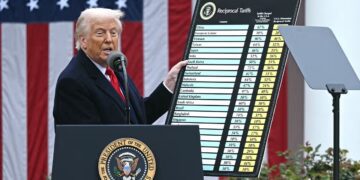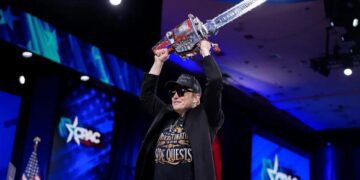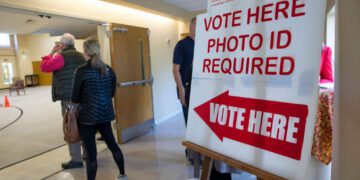By John F. Di Leo –
On Monday, December 28, 2015, Chicagoland was hit by a particularly unpleasant ice storm.
No, not a blizzard – we get them every year – this was an ice storm, the kind where you’re peppered by tiny bits of ice as you walk or run to your car, the kind that leaves inches of slush and ice on the ground instead of nice soft snow. The kind that’s even more painful, even more dangerous, than most snowstorms. The kind that weighs down power lines, causing them to collapse and leave whole towns without power.
It wasn’t the worst of the storms that hit the country this week, however. Other areas got snow, lots of it. Other areas got rain, as much as a foot in one day. Other areas were hit by dozens of fatal tornadoes. No, we Chicagoans don’t have anything to complain about. We know how to drive in snow; we know how to dress for it. Many others had it far worse than we did, this week at least.
But for many, the oddity of this weather system – particularly after a mild December and a generally mild year overall for some regions, raised the issue – yes, a political issue – that “weather is changing these days,” that weather is somehow different now than it used to be.
It’s not. We’ve never had ice storms every year, but we’ve always had them once every several years.
And it’s the same in every state that got hit. Every one of them gets torrential rains, or tornadoes, or blizzards, now and then. For most of us, it isn’t every month, or even every year, but every several.
We have a few years of mild winters, then a few years of frigid and snowy ones, then back and forth again. Weather doesn’t repeat itself every week or every year, but there are systems, and there are averages.
Every Generation
I remember my parents shaking their heads at the demonstrators of the 1970s, chuckling at how “young people always think they invented rebellion.” After seeing college kids get hammered, they’d say “young people always think they’re the first ones to discover alcohol.”
To the young, or perhaps to the sheltered, especially in the absence of decent history classes in the schools, everything that hasn’t happened within their memory is new to them. They see their first ice storm, and think it’s the first one that’s ever hit. They see their first tornado, and think the very earth is attacking mankind for the first time.
If they haven’t studied Pompeii in 79 AD, or Tambora in 1815, or Krakatau in 1883, volcanoes are new to them, so recent eruptions like Pinatubo in 1991, and the ongoing activity at Mount St. Helens in the 1980s and 1990s lead them to assume that the very Earth has suddenly rejected our civilization and attacked us.
If their teachers never took the time to tell them about Galveston in 1900, Corpus Christi in 1919, Lake Okeechobee in 1928, and Camille in 1969, then Hurricane Katrina in 2005 was an unprecedented disaster, rather than just another in a long history of awful natural events, for which the locals were tragically unprepared.
So today, when their teachers tell them that a sentient planet is consciously rebelling against mankind, and punishing us for our many imagined sins – daring to live our lives as we desire rather than as the elitist Left wants us to – they have no frame of reference leading them to question it; they may just listen and believe.
Those of us who are older, or who have paid better attention, have seen it all before. We know that there’s nothing new about “climate change” – that there have been hot periods and cool periods, calm periods and volatile periods, for as long as the earth has been spinning, not only throughout recorded history, but long before as well.
Could we have had four ice ages before the dawn of civilization without cold spells? Could we have recovered from those four ice ages – with massive glaciers receding as a result – without warm spells too?
Back in the days when schools taught history, and science, and reason, our college graduates – and our high school graduates and even grammar school graduates as well – would have been able to see through the fear-mongering of the climate worrywarts. But such subjects have long since been displaced, to make room in the curriculum for physical education, and sex education, and shop, and environmental science.
Now that all their education, for generations now, has been skewed by politics, can we blame the gullible for assuming that everything today is new and unprecedented, that all of today’s problems must be the result of mankind’s actions?
When the Cure is Worse than the Disease
For a generation now, the theory of “manmade global warming” – quietly and subtly renamed “manmade climate change” when the massive fraud of the hockey stick graph and the IPCC email scandal became too huge to deny anymore – has been drummed into the school system, the mass media, and the popular culture.
“Manmade climate change” has practically become a religion for the modern Left, so, with religious fervor, the political parties they control have woven its themes into their every policy prescription.
The old soft environmentalism of the 20th Century – filter your emissions, recycle your waste, make sure that factories put back the air and water cleaner than they take them in – has been successful, wherever it’s been tried, in its alleged goal to improve the environment. But that’s not enough for them. Without a crisis to manage, the government has no justification for the regulations, laws, taxes and fees – and bureaucracy! – that they desire to impose on the rest of us.
When there was a real, definable problem – polluted air, polluted rivers, polluted lakes – we could set in place a real, defined solution. It worked, but when the solution is accomplished – as it has been, in the developed West at least – there’s nothing left for their staffs to do, no more reason to employ them at every level of government in every country they rule.
So the Left created a new problem – “manmade climate change” – in the full knowledge that it’s fictional, for a reason: if they can invent the problem, they can constantly reset the bar, so that their “solutions” are always necessary to address it. When the goal is a moving target, they can always come up with new ways to cure the disease.
The theory of manmade climate change is that man’s use of “greenhouse gases” will heat the world so much that our polar ice caps will melt, causing the oceans to rise, flooding low-lying coastal cities. There is no true evidence that anything mankind has done REALLY causes global temperature changes – the solitary eruption of a single large volcano dwarfs the pollution output of an industrialized nation, after all – but they have convinced enough people that it does, that many voters will happily allow the Left to impose their demands.
And how extreme those demands have become!
We are ordered to cut our energy usage, not even BY a fraction, but TO a fraction, of our current usage. We are ordered to cease the use of oil, coal, and wood, and we are forbidden from increasing the one proven form of energy that could replace them – nuclear – for other reasons. Accepting their rule would eliminate virtually all of the manufacturing that remains in these United States, because the paltry amount of energy produced by their approved methods – solar, wind, and algae – would never produce enough energy to heat and cool our residences, let alone address the nation’s commercial needs.
Every aspect of our lives – from the family car, to the shopping mall and restaurant, to the home and school, to the office building and the factory – is powered by energy. Forcibly remove that supply – as the Left intends, and as the Obama administration has already made inroads in doing – and we are no longer America. The goal of the Left – if we were to let them win this argument and fully implement their plans – would be to virtually wipe out the American way of life.
From the Productive to the Counter-Productive
But the most shocking of all aspects of “manmade climate change” economics is how absolutely counterproductive it is.
America was once a productive economy, arguably the most productive one on earth. The system encouraged entrepreneurship, so new businesses sprang up. The system facilitated manufacturing of all kinds, so there could be both jobs for sustenance and opportunities for successful career tracks, from border to border and from sea to shining sea. A growth economy provides opportunities for everyone, at every talent level.
Such an economy needs a minimal safety net, and can provide enough tax revenue for government to concentrate on its proper functions, such as national defense and infrastructure.
Over a century ago, when Galveston was leveled by a hurricane, when San Francisco was leveled by an earthquake, when Chicago was burnt to the ground by fire, we could afford to rebuild.
The entire city of Galveston was raised above sea level; Chicago replaced clapboard firetraps with more fire-resistant buildings of brick and stone, glass and metal. San Francisco built earthquake-resistant buildings, even a world-renowned earthquake-resistant bridge. We built stronger, better buildings and roads after these catastrophes not only because we learned our lesson, but because we could afford to.
By the same token, if the climate fear-mongers should miraculously turn out to have been right – without the slightest bit of real evidence to support them – then the only real downside to a slightly warmer climate will be the possibility of flooding in some low-lying coastal cities. Charleston, New Orleans, and similar communities might need to be protected, shored up like Galveston was, a century ago.
But such projects cost money. For example, the city of Galveston was raised ten to seventeen feet, over the course of a six year project, using 16 million cubic yards of sand. By 1910, the city was so much higher, it was considered safe from the dangers that the storm of 1900 had posed.
With today’s technology, such a task could be made even more successful, but it’s expensive. You have to be able to afford to build seawalls, or to install massive pumps like the ones installed at New Orleans after Hurricane Katrina. There are many ways to protect low-lying coastal towns and ports, but they all cost money.
And one of the many fatal flaws of the Left’s proposed response to “climate change” is that the economic constriction that it causes will necessarily eliminate government’s ability to perform those infrastructure improvements!
Government needs tens of millions of dollars – even hundreds of millions, depending on the size and scope of the project – to render these areas safe. In many cases, even if the fear-mongering of “manmade climate change” is hogwash (as most rational people acknowledge), all the proven risks of hurricanes, tornadoes, earthquakes, wildfires, and all other natural disasters are still very real, and well worth preparing for.
Society NEEDS to defend our cities from these risks. Even if Al Gore and his acolytes’ warnings of rising oceans never come to pass, there will always be storms; there will always be volcanoes, there will always be earthquakes.
The Left’s shortsighted and suicidal response to one unproven risk – ordering the strangulation of the global economy, in a vain hope to retard an unlikely but possible change in sea levels – will actually eliminate our ability to respond to it if it happens anyway, AND will eliminate our ability to guard against the thousands of other risks that remain all too real, no matter what.
Where Are We Today?
The picture above shows the parking lot of a Chicago suburban Walmart, during Monday’s ice storm. The Walmart is thriving, but in direct contradiction to the usual laws of retail, the outlots are not. More than half the storefronts ringing the parking lot are vacant, despite the Walmart – the anchor store of the area – being perpetually busy from open to close. Why haven’t other businesses thrived in the orbit of such a sun?
The real estate press tells us the reason is overbuilding; they write that America built too many strip malls, too many office buildings, too many factories, too many enclosed malls, in the golden years of the Twentieth Century. They tell us we overbuilt, so we can’t complain that there are vacancies.
But they are completely wrong.
The official US population tripled in the Twentieth Century, growing from 76 million in 1900 to 281 million by 2000. Our population grew by 32.7 million in the 1990s alone. And that’s just the official population; we all know there are at least twenty million more when you count the ballooning population of illegal aliens.
With such a massive increase in both workforce and consumer base, there is no good reason why industrial and commercial real estate shouldn’t grow to accommodate it. There are workers and shoppers to keep all these places occupied. If the economy had been allowed to grow along with the population, the nation would have prospered, and those empty buildings would be full and thriving.
But the concurrent growth of government has already strangled the growth of the private sector to the point of economic sterility. The highest corporate tax rate on earth, the most oppressive regulatory climate on earth, and among the most challenging labor climates on earth, have made this nation a hostile environment to both new and existing businesses.
At precisely the time when technology allows for society to protect itself better from natural dangers than ever before, the tax-and-regulatory structure imposed on this nation by the Left renders such defense unaffordable.
We clearly need government – at all levels – to lower the tax burden, cut the red tape, and remove the anti-employer bias of the courts. Only conservatives and libertarians – not Democrats, not the Republican establishment, but real conservatives and libertarians, in the mold of our Founding Fathers – understand this need and can be trusted to meet it.
With a shrinking of the Leviathan state, we can, and will, grow ourselves out of the Obama-era economic malaise. We can, and will, again employ the 90-some million Americans currently outside the workforce. We can, and will, again make America the economic engine of the world.
And when we do, even with much lower tax rates (as the Reagan era proved), we will have the necessary tax revenues to install those pumps, to build those seawalls, to defend areas at risk from nature’s real threats.
And in so doing, just by coincidence, we’ll be better defended from nature’s unlikely threats as well, the ones that Al Gore and his allies have invented entirely for their own profit and electoral advantage.
We must learn from history, and we must act now. It is time to unleash the limitless potential of limited government, and allow our economy to grow again.
Copyright 2015 John F. Di Leo
John F. Di Leo is a Chicago-based Customs broker and international trade expert. A former County Chairman of the Milwaukee County Republican Party, he has now been a recovering politician for eighteen years (but, like any addiction, you’re never fully cured).
Permission is hereby granted to forward freely, provided it is uncut and the IR URL and byline are included. Follow John F. Di Leo on Facebook or LinkedIn, or on Twitter at @johnfdileo, or on his own website at www.JohnFDiLeo.com.







